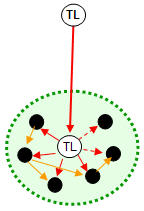Teams Are the Working Perspective of the Organization |
Teams, groups with common purpose and shared tasks, are the essence of human organizations. These are the “units of collaboration” that run the processes and operations of the organization, the horizontal flows that complement the vertical guidance network.
People work in teams, and organizations work through teams. Teams are the “middle way” between the formal top-down organizational perspective and the personal-positional perspective of my roles and relationships. Inside teams, the true complexity of getting stuff done is managed, while the organization expects outcomes from teams that serve the overall purpose.
Teams are the 1-degree of separation circles of relationships within which people operate on a daily basis. |
| |
Each role is part of a team
A team is a network of roles
There is a hierarchy of management teams (employee reports) with a fixed positional manager role
There is a larger leadership-membership network of all the formally recognized teams that enable the organization to function
There is apparently a near-universal role, team leader (TL)
Teams function as (1) resources or as (2) workflows
Work flows within and between teams
Workflow teams have some process links between roles
Within teams, members may play predominately resource or workflow roles
There is a core teamnet of critical-path workflow that carries the organization’s work from the earliest inputs to the final outputs
|
|
|
Myth: Teams are at the bottom of the hierarchy
Reality: Everybody works in teams at all levels of organizational structure
